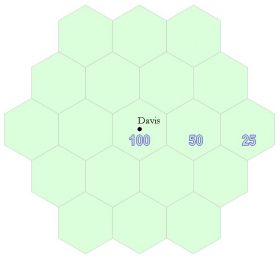Infrastructure
Infrastructure describes the framework of civilisation that exists in a specific 20-mile hex map, based upon a region's population and the distribution of that population. The latter is affected by the geographical elevation of the hex as compared with other hexes in the same political region. Since infrastructure relies upon the willingness of a specific region to build public works within its control, the measure of a region's infrastructure is limited by the boundaries of that region. Therefore, a hex that's part of a dense political entity, with a very high infrastructure, can be directly adjacent to a wilderness when the two hexes are separated by a state border.
Infrastructure is used to determine the presence and nature of roads, what services are provided, cultural cohesion, education, manufacturing, wealth, agricultural development and much more. Zero infrastructure indicates the hex is wild, with no institutions or development of any kind. Backward areas have infrastructures between 1-7; mixed hinterland & rural parts, between 8-31; well-established agricultural zones, towns and small cities, between 32-99. Dense areas will have hundreds of infrastructure, with some very dense populated areas having infrastructures in the thousands.
Calculating Infrastructure
The system that calculates the infrastructure number is greatly affected by population, but does not describe a hex's population. A hex that is wholly rural can have half the infrastructure of an adjacent, densely packed urban hex — because the latter ensures that roads and installations are built in the former for general public use. Here follows a series of examples that explains how infrastructure is calculated and how it's affected by settlement location and topographic forms.
Population
Before infrastructure can be determined, we must know the FULL population of the region. This number can be arbitrarily assigned or calculated through whatever means the DM wishes. This full population needs to be subdivided among any number of towns or cities the DM cares to list in that given region.
The first very simple example shows a region with one town, Davis. The whole region has a population of 34,600 persons, with all political decisions make within Davis; and therefore, all infrastructure is centered in and around Davis. The land represented is flat as a pancake, so there are elevational obstructions to the building of roads Each hex is 20 miles in diameter and 346 square miles. The total area is 8,650 sq. miles, nearly the size of New Jersey.
To obtain a single infrastructure number, we divide the total population by 346, the square miles per hex. This gives us a number of 100, which is the infrastructure of the hex that contains the only settlement Davis. All six hexes around the Davis hex have an infrastructure of 50, half of the Davis hex. And all hexes that are two away from Davis have an infrastructure of 25. If a third circle of hexes existed, they'd all have an infrastructure of 12 (fraction is ignored). This continues until a border is reached or until the infrastructure falls below 1, indicating a hex without infrastructure. In this case, the border is the edge of the 25 hexes, so there is no need to calculate the region's infrastructure beyond what's seen here.
An example like this would hardly occur in the real world. Flat areas like this tend to be agricultural, with multiple settlements. Regions are also irregularly shaped; New Jersey is surrounded by water, for example. However, let's continue with the example, this time splitting the population between three centres. We'll retain the total infrastructure of 100 points.
